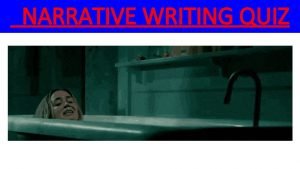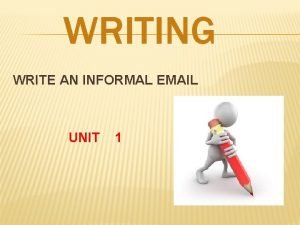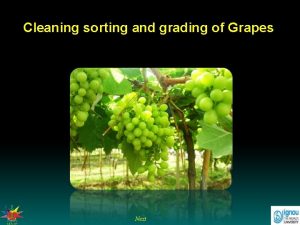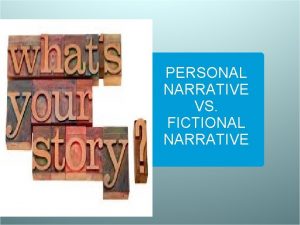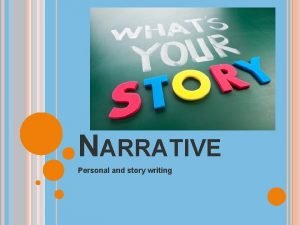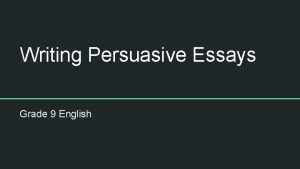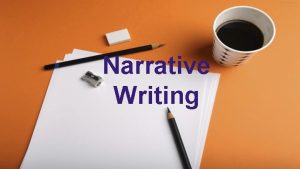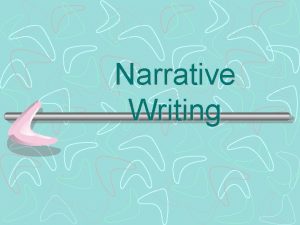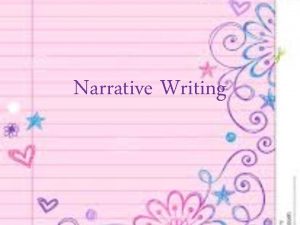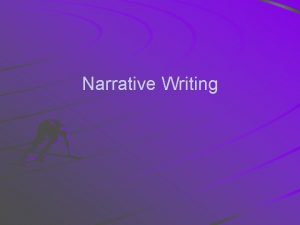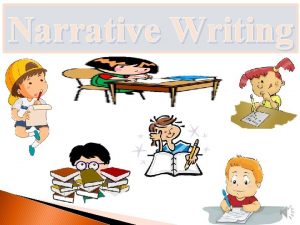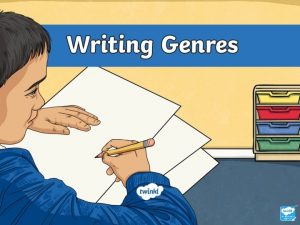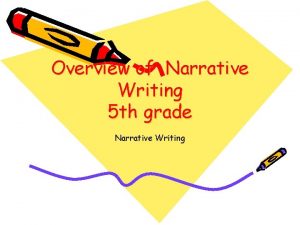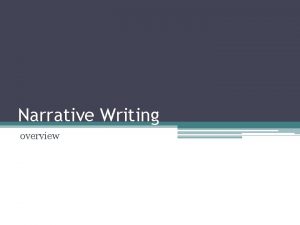Overview of Narrative Writing 5 th grade Narrative










- Slides: 10

Overview of Narrative Writing 5 th grade Narrative Writing

Defining Narrative Writing • Narrative Writing: Writing that tells a story or gives an account of something that has happened. The purpose is to recount a story grounded in personal experience or the writer’s imagination. • Method: • Uses a setting, characters, circumstances or events, a plot, a point of view, and a sense of resolution to tell a story. • Description of these elements is a key factor. • May employ strategies such as flashback, foreshadowing, dialogue, tension, or suspense.

What Narrative Writing Is and Is Not An effective narrative composition is NOT. An effective narrative composition. . . Tells a personal or imaginative story A list of events and/or facts May include the writer’s imagination and personal experiences that are related to the story An abundance of facts or personal anecdotes that are unrelated to the topic Contains narrative elements such as characters, plot, point of view, setting, conflict, and/or significant events A list of reasons, opinions, or unrelated episodes Contains narrative strategies such as, flashback, foreshadowing, dialogue, tension and/or suspense Formulaic, repetitive writing Is multi-paragraph A single paragraph Presents a story that has a well-developed beginning, middle, and end A paper that lacks a clear beginning, middle, and end

What Narrative Writing Is and Is Not An effective narrative composition. . . An effective narrative composition is NOT. . . Uses a lively writing voice to engage the reader Flat, uninteresting writing Uses vivid sensory details and concrete language A story that contains imprecise language Uses a variety of sentences A story with little sentence variety Contains correct sentences, usage, grammar, and spelling that make the writer's ideas understandable Incorrect sentences, usage, grammar, and spelling that prevent the reader from understanding the writer's ideas

Overview of Ways to Organize Narrative Writing Purpose: What story is the writer telling? -Beginning -Middle -End Flashback: -End (most dramatic event) -Beginning -Middle -Beginning -Situation or Conflict -Climax -Resolution of the conflict

Focus in Narrative Writing • In narrative writing, the focus of the story may be character development, the plot, a setting and time period, or a deeper theme. • Part of maintaining focus is selecting relevant details that advance the story and leaving out information that may distract the reader from the focus of the story. • The focus is usually implied rather than stated directly. • Maintaining a clear point of view also indicates focus.

Narrative Purpose • The purpose of a narrative is to tell a story and capture the reader’s interest. • Writers may have many purposes for telling a specific story: – Some stories have a meaning that goes deeper than simply the events. – Sometimes the writer has a point to make. – Sometimes the writer wants the reader to understand something personal about himself/herself or to present a lesson about living.

Character Development • Characters can be developed through: • Action – What the characters do, feel, or think • Dialogue – What the characters say • Description – What the characters look like

Types of Language • Interesting Language • Sensory Details: what the characters see, hear, taste, smell, and feel. Writers use details that appeal to the senses to help the reader imagine the events of the story. • Descriptive: conveys an idea, image, or impression. • Figurative: figures of speech or phrases that suggest meanings different from their literal meanings (hyperbole, metaphor, simile, irony). • Simple, Ordinary Language • common words that are correct but not precise.

Narrative Organizational Patterns • • • Beginning, middle, end Flashback: end, beginning, middle Beginning, situation or conflict, climax, resolution of the conflict
